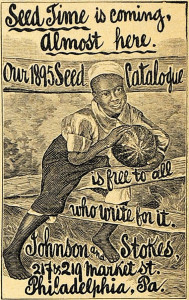As interest in the environment grows this includes collecting old garden catalogs. Colorful and informative, they give a glimpse into the past of what were the popular foods of the past. The early catalog drawings are considered works of art, also illustrated on seed boxes and tin containers.
Pages from 19th century garden catalogs were not only hand drawn but often hand colored. Equally colorful were the fruit labels on wooden crates. Framed and hung on a kitchen wall they have become a decorative art accessory.
However, for the serious collectors of old garden catalogs, such a destruction of a total catalog is a sacrilege. As they see it, it’s like cutting up a rare book and framing the pictures. Literally destroying a piece of American garden history.
Many reflect the foods and plants in the regions in which they originated. For example, the farm county publications used rustic, “homey” words to describe the plants. The city-produced catalogs rely on more “hard-sell.”
Among the earliest seed companies were Burpees Seeds (1876) and D.M. Ferry (1880s.) For their hundred year anniversary in 1976, Burpees issued Centennial place mats featuring color reproductions from their historic, lithographed catalog pages. These days they are considered collectibles.
Among the rarest and most valuable spin-offs for collectors would be books (written by and illustrated) in the early 19th century as guides for explorers. Often they contained hand colored illustrations detailing the discoveries of exotic and unusual jungle area plants. Who can forget the mission of the ship Bounty to bring back breadfruit trees.
 CLUES: Not everybody appreciates garden collectibles. There’s still a chance to make discoveries at bargain prices. Fruit crate labels were once throw aways. Once collectors got wise they were reproduced in the 1970s. Garage sales and flea markets are still a good place to find catalogs and old fruit crates.
CLUES: Not everybody appreciates garden collectibles. There’s still a chance to make discoveries at bargain prices. Fruit crate labels were once throw aways. Once collectors got wise they were reproduced in the 1970s. Garage sales and flea markets are still a good place to find catalogs and old fruit crates.
The good news is there are still 1877, Burpees catalogs, with its fifty plates intact. Only 10,000 were printed. Those that survived are rarities worth over $100.
PHOTO CAPTION: (1) 1895 Johan Stokes seed catalog. PHOTO CREDIT: (1) Period Paper, eBay.
PHOTO CAPTION : (2) 1902 Childs’ Bulbs and Plants.
PHOTO CREDIT: (2) Private Collector
















Follow Us